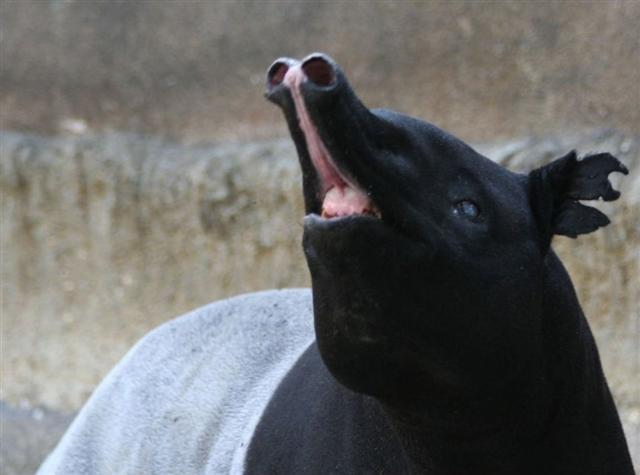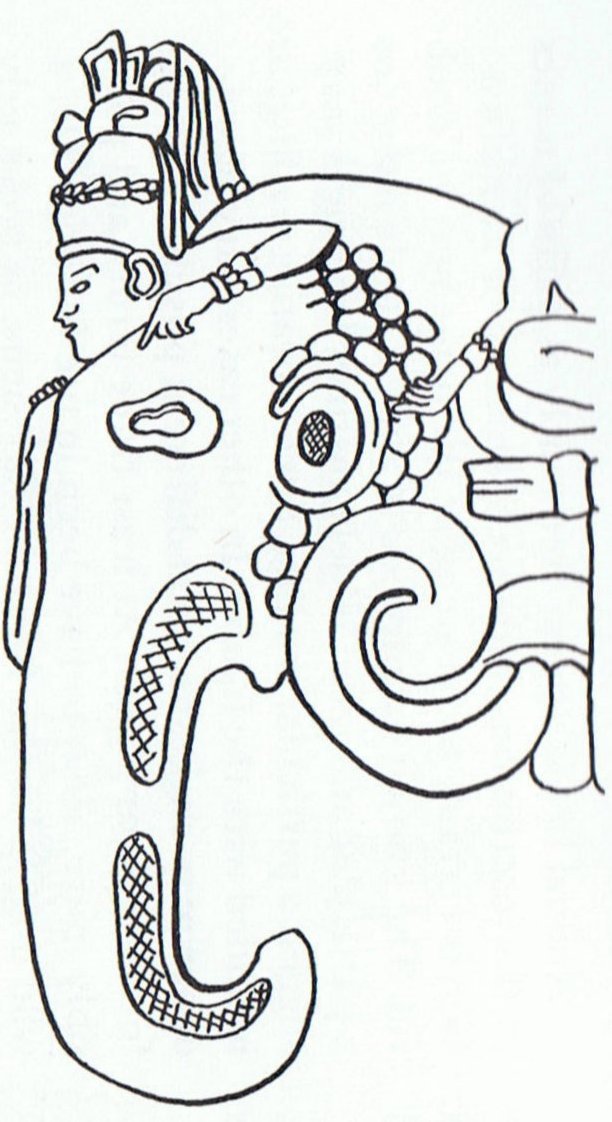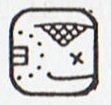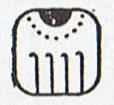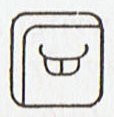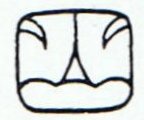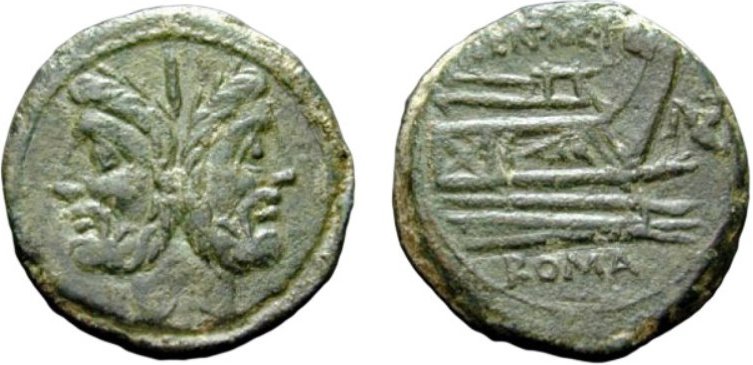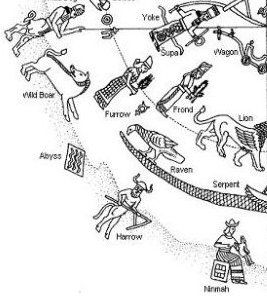99. The Earth Turtle (Pawahtun) was where the Sun went down into the Underworld (Xibalba) at the horizon in the west (at Chikin, the Grasping Hand):
But the Earth Turtle was also in the east where she would give birth to a new Sun. The face of the Earth stretched in both directions across from the horizon in the east to the horizon in the west, and this was the Middleword, with its center pierced (huki) by the Tree (Te Rakau) - i.e. by the Digging Stick (Te Huki):
The Middleworld was characterized by number 7 and Xibalba by number 9, and 7 * 13 = 133 = May 13. In Cb2-3 maro (in form of 6 hanging 'feather months' in front) could have indicated a state of infertility caused by drought. Mother Earth was thirsty. There were 9 * 7 = 63 right ascension days (9 weeks) from Sirrah to Hyadum I at the end of side b on the G tablet:
Ceremonies for inducing the Sun to climb higher (manu kake) in order to be able to produce rain (te ua) might possibly have reached the desired results only after Acrux had culminated (at 21h in the evening).
Manu kake rua in Ca14-26, where 14 * 26 = 364 = 389 - 25, was not the typical kind of manu kake.
Its 'central pillar' was more like a creature emerging after having been covered up (puo). Possibly it was caused by cold fresh water (vai) fetched up from a hole in the ground, from a well (puna):
The first 3 Mayan day signs were Water, Air, and Night. Water came first:
Rua (in manu kake rua) could for instance imply a hole in the ground (or to spit out) - i.e. like the beginning of the 2nd phase of the Sun after having completed his sucking up (cfr Omotohi as the name for the Full Moon) of all the waters from the ground.
If my interpretation is correct, it could take 420 (= 7 * 60) days - 389 (Ca14-26) = 29 + 2 days before the rains materialized. The Moon was visible for 29 nights, then her back side (●) was bathed in the vitalizing rays from Tane, making her grow (tupu) once again. .... When the new moon appeared women assembled and bewailed those who had died since the last one, uttering the following lament: 'Alas! O moon! Thou has returned to life, but our departed beloved ones have not. Thou has bathed in the waiora a Tane, and had thy life renewed, but there is no fount to restore life to our departed ones. Alas ...
The Chorti sky raisers had completed their task when the rains arrived and they had begun their ceremonies in 25 April (115). And 115 + 31 (= 29 + 2) = 146 = 2 * 73 (= 2 / 5 * 365). By counting 73 days (glyphs) ahead from Cb2-7 (MARCH 14, 3-14, 146 = 2 * 73) we will reach day 3 * 73 = 216 (AUGUST 4) and 31 (Cb2-7) + 73 = 104 (Cb5-10) = 8 * 13:
The Explorers had left their old homeland in Vaitu Nui 25 according to Manuscript E. But this date implied much water and surely when they arrived to Easter Island it was at the beginning of the dry month (Maro 1). If these dates corresponded to what was due at the time of Bharani (*41) then their journey would have begun approximately at heliacal Cursa (β Eridani) and this was 11 days after Achernar (α Eridani). The right (and daytime, not string like) 'sky raising' hand in Ga1-12 was dry
but not the left one in front, which was more benevolent in 'giving' (handing over):
When north of the equator June (the month of Jus-piter, Father Light) indicated high summer it had to be the opposite on Easter Island, a season when the Sun was absent. Therefore the Explorers could not complete their visit on Easter Island until half a year after their arrival, in Tangaroa Uri 25, after the Sun had been successfully induced to return. Makoi (Saturn) was given the task to put the proper names on the sacred map of Easter Island and Kuukuu (Mars) was ordered to work the ground. He should make furrows with his tools and then heap up earth for the roots. ... During his descent the ancestor still possessed the quality of a water spirit, and his body, though preserving its human appearance, owing to its being that of a regenerated man, was equipped with four flexible limbs like serpents after the pattern of the arms of the Great Nummo. The ground was rapidly approaching. The ancestor was still standing, his arms in front of him and the hammer and anvil hanging across his limbs. The shock of his final impact on the earth when he came to the end of the rainbow, scattered in a cloud of dust the animals, vegetables and men disposed on the steps. When calm was restored, the smith was still on the roof, standing erect facing towards the north, his tools still in the same position. But in the shock of landing the hammer and the anvil had broken his arms and legs at the level of elbows and knees, which he did not have before. He thus acquired the joints proper to the new human form, which was to spread over the earth and to devote itself to toil ... But first they had all together to go up to the top and there to construct a Ηouse (a place for birth):
North of the equator the Babylonians had named Aldebaran (marking the arrival of the summer half of the year) Pidnu-sha-Shame = Furrow of Heaven. And they had given the area above their Abyss (at the other side of the year compared to their watery Field) the pair of names Furrow and Frond - perhaps to indicate how the greenery would rise from the furrows (if they were properly irrigated). Beyond Leo came the waiting Virgin Mother Earth and once upon a time Spica would have risen heliacally in day *202 - 64 = *138 (AUGUST 6).
Consequently it should be suitable to let someone dig furrows in the dry month of Maro. We can see a digging tool (huki) in the hands of Harrow, a Bull man. This tool is shaped like the letter A.
... Ebony label EA 32650 from Den's tomb. The upper right register depicts king Den twice: at the left he is sitting in his Hebsed pavilion, at the right he is running a symbolic race around D-shaped markings. This ceremony is connected to the so-called 'race of the Apis bull'. The middle right section reports about the raid of the city 'beautiful door' and about a daughter of Den suffering from an unknown disease. The lower right section reports about the visitation of the 'souls of Peh' at the royal domain 'Wenet'. The left part of the label describes the content of the vessel that once belonged to the label and mentions the high official Hemaka [cfr Hau Maka] who was obviously responsible for the delivery of the labeled jar ... ... Instead of that old, dark, terrible drama of the king's death, which had formerly been played to the hilt, the audience now watched a solemn symbolic mime, the Sed festival, in which the king renewed his pharaonic warrant without submitting to the personal inconvenience of a literal death. The rite was celebrated, some authorities believe, according to a cycle of thirty years, regardless of the dating of the reigns; others have it, however, that the only scheduling factor was the king's own desire and command. Either way, the real hero of the great occasion was no longer the timeless Pharaoh (capital P), who puts on pharaohs, like clothes, and puts them off, but the living garment of flesh and bone, this particular pharaoh So-and-so, who, instead of giving himself to the part, now had found a way to keep the part to himself. And this he did simply by stepping the mythological image down one degree. Instead of Pharaoh changing pharaohs, it was the pharaoh who changed costumes. The season of year for this royal ballet was the same as that proper to a coronation; the first five days of the first month of the 'Season of Coming Forth', when the hillocks and fields, following the inundation of the Nile, were again emerging from the waters. For the seasonal cycle, throughout the ancient world, was the foremost sign of rebirth following death, and in Egypt the chronometer of this cycle was the annual flooding of the Nile. Numerous festival edifices were constructed, incensed, and consecrated; a throne hall wherein the king should sit while approached in obeisance by the gods and their priesthoods (who in a crueler time would have been the registrars of his death); a large court for the presentation of mimes, processions, and other such visual events; and finally a palace-chapel into which the god-king would retire for his changes of costume. Five days of illumination, called the 'Lighting of the Flame' (which in the earlier reading of this miracle play would have followed the quenching of the fires on the dark night of the moon when the king was ritually slain), preceded the five days of the festival itself; and then the solemn occasion (ad majorem dei gloriam) commenced. The opening rites were under the patronage of Hathor. The king, wearing the belt with her four faces and the tail of her mighty bull, moved in numerious processions, preceded by his four standards, from one temple to the next, presenting favors (not offerings) to the gods. Whereafter the priesthoods arrived in homage before his throne, bearing the symbols of their gods. More processions followed, during which, the king moved about - as Professor Frankfort states in his account - 'like the shuttle in a great loom' to re-create the fabric of his domain, into which the cosmic powers represented by the gods, no less than the people of the land, were to be woven ... The king, wearing now a short, stiff archaic mantle, walks in a grave and stately manner to the sanctuary of the wolf-god Upwaut, the 'Opener of the Way', where he anoints the sacred standard and, preceded by this, marches to the palace chapel, into which he disappears. A period of time elapses during which the pharaoh is no longer manifest. When he reappears he is clothed as in the Narmer palette, wearing the kilt with Hathor belt and bull's tail attatched. In his right hand he holds the flail scepter and in his left, instead of the usual crook of the Good Shepherd, an object resembling a small scroll, called the Will, the House Document, or Secret of the Two Partners, which he exhibits in triumph, proclaiming to all in attendance that it was given him by his dead father Osiris, in the presence of the earth-god Geb. 'I have run', he cries, 'holding the Secret of the Two Partners, the Will that my father has given me before Geb. I have passed through the land and touched the four sides of it. I traverse it as I desire.'
Maro 10 ("June 10) = day 161 had been at such stars which were rising with the Sun in day 81 after 0h (or in day 77 after day 84). But at the time of rongorongo these stars would have moved ahead in the year to day 81 + 41 = 122 after 0h (or to day 77 + 41 = 118 = 4 * 29½ after day 84). I.e. to day 80 + 122 = 202 (July 21) = 84 + 118 = 4 * 21 + 4 * 29½. And - as if by chance - at the time of rongorongo Spica rose heliacally 80 days later, in October 9 (*202).
... His wife sang a dirge of lament, but did precisely as she was told, and in the morning she found her house surrounded by a perfect thicket of vegetation. 'Before the door,' we are told in Thomas Thrum's rendition of the legend, 'on the very spot where she had buried her husband's heart, there grew a stately tree covered over with broad, green leaves dripping with dew and shining in the early sunlight, while on the grass lay the ripe, round fruit, where it had fallen from the branches above. And this tree she called Ulu (breadfruit) in honor of her husband ...  |
||||||||||||||||||||||||||||||||||||||||||||||||||||||||||||||||||||||||||||||||||||||||||||||||||||||||||||||||||||||||||||||||||||||||||||||||||||||||||||||||||||||||||||||||||||||||||||||||||||||||||||||||||||||||||||||||||||||||||||||||||||||||||||||||||||||||||||||||||||||||||||||||||||||||||||||||||||||||||||||||||||||||||||||||||||||||||||||||||||||||||||||














